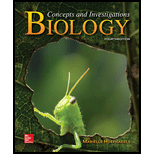
Concept explainers
Which of the following is NOT a feature associated with viruses?
- a. Cytoplasm
- b. Genetic in formation
- c. Protein coat
- d. Envelope
Introduction:
A virus is a small infectious agent that can’t be seen through the naked eyes. Viruses are made up of protein coat in which their genetic material is present. The viruses contain either double stranded or single stranded DNA or RNA as their genetic material.
Answer to Problem 1MCQ
Correct answer:
Cytoplasm is not the feature associated with viruses. Therefore, option a. is correct.
Explanation of Solution
Reason for the correct statement:
The structures of the virus is simple that lacks the basic characteirstics of the cells. It does not have organelles, ribososmes, nucleus, cytoplasm or even a cell membrane.
Option a. is given as “Cytoplasm”.
As, “the feature that is NOT associated with viruses is cytoplasm”, is the right answer.
Hence, option a. is correct.
Reasons for the incorrect statements:
Option b. is given as “Genetic information”.
All the viruses carry genetic material which guide the synthesis of proteins, since it is the feature of viruses. So, it is a wrong answer.
Option c. is given as “Protein coat”.
Protein coat is also known as capsid which surrounds the genetic material, since it is the feature of viruses. So, it is a wrong answer.
Option d. is given as “Envelope”.
Envelope is protein and lipid rich outer layer. It is derived from the host’s cell embrane parts, since it is the feature of viruses. So, it is a wrong answer.
Hence, option b., c., and d. are incorrect.
The viral structure lacks cytoplasm. Thus this feature is not associated with viruses.
Want to see more full solutions like this?
Chapter 16 Solutions
Biology: Concepts and Investigations
Additional Science Textbook Solutions
Physics for Scientists and Engineers
Chemistry & Chemical Reactivity
Genetics: From Genes to Genomes
Campbell Essential Biology (7th Edition)
- In one paragraph show how atoms and they're structure are related to the structure of dna and proteins. Talk about what atoms are. what they're made of, why chemical bonding is important to DNA?arrow_forwardWhat are the structure and properties of atoms and chemical bonds (especially how they relate to DNA and proteins).arrow_forwardThe Sentinel Cell: Nature’s Answer to Cancer?arrow_forward
- Molecular Biology Question You are working to characterize a novel protein in mice. Analysis shows that high levels of the primary transcript that codes for this protein are found in tissue from the brain, muscle, liver, and pancreas. However, an antibody that recognizes the C-terminal portion of the protein indicates that the protein is present in brain, muscle, and liver, but not in the pancreas. What is the most likely explanation for this result?arrow_forwardMolecular Biology Explain/discuss how “slow stop” and “quick/fast stop” mutants wereused to identify different protein involved in DNA replication in E. coli.arrow_forwardMolecular Biology Question A gene that codes for a protein was removed from a eukaryotic cell and inserted into a prokaryotic cell. Although the gene was successfully transcribed and translated, it produced a different protein than it produced in the eukaryotic cell. What is the most likely explanation?arrow_forward
- Molecular Biology LIST three characteristics of origins of replicationarrow_forwardMolecular Biology Question Please help. Thank you For E coli DNA polymerase III, give the structure and function of the b-clamp sub-complex. Describe how the structure of this sub-complex is important for it’s function.arrow_forwardMolecular Biology LIST three characteristics of DNA Polymerasesarrow_forward
 Concepts of BiologyBiologyISBN:9781938168116Author:Samantha Fowler, Rebecca Roush, James WisePublisher:OpenStax College
Concepts of BiologyBiologyISBN:9781938168116Author:Samantha Fowler, Rebecca Roush, James WisePublisher:OpenStax College Biology (MindTap Course List)BiologyISBN:9781337392938Author:Eldra Solomon, Charles Martin, Diana W. Martin, Linda R. BergPublisher:Cengage Learning
Biology (MindTap Course List)BiologyISBN:9781337392938Author:Eldra Solomon, Charles Martin, Diana W. Martin, Linda R. BergPublisher:Cengage Learning Biology Today and Tomorrow without Physiology (Mi...BiologyISBN:9781305117396Author:Cecie Starr, Christine Evers, Lisa StarrPublisher:Cengage Learning
Biology Today and Tomorrow without Physiology (Mi...BiologyISBN:9781305117396Author:Cecie Starr, Christine Evers, Lisa StarrPublisher:Cengage Learning
 Medical Terminology for Health Professions, Spira...Health & NutritionISBN:9781305634350Author:Ann Ehrlich, Carol L. Schroeder, Laura Ehrlich, Katrina A. SchroederPublisher:Cengage Learning
Medical Terminology for Health Professions, Spira...Health & NutritionISBN:9781305634350Author:Ann Ehrlich, Carol L. Schroeder, Laura Ehrlich, Katrina A. SchroederPublisher:Cengage Learning





